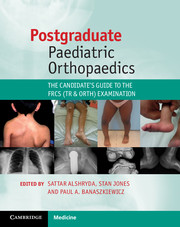Book contents
- Frontmatter
- Contents
- List of contributors
- Foreword
- Preface
- Acknowledgements
- Interactive website
- List of abbreviations
- Section 1 General guidance
- Section 2 Core structured topics
- Chapter 3 The hip
- Chapter 4 The knee
- Chapter 5 The foot and ankle
- Chapter 6 The spine
- Chapter 7 The shoulder
- Chapter 8 The elbow
- Chapter 9 Congenital hand deformities
- Chapter 10 Neuromuscular diseases
- Chapter 11 Musculoskeletal infections
- Chapter 12 Musculoskeletal tumours
- Chapter 13 Skeletal dysplasia
- Chapter 14 Metabolic bone disease
- Chapter 15 Physis and leg length discrepancy
- Chapter 16 Deformity corrections
- Chapter 17 Miscellaneous paediatric conditions
- Section 3 Exam-related material
- Index
- References
Chapter 8 - The elbow
Published online by Cambridge University Press: 05 August 2014
- Frontmatter
- Contents
- List of contributors
- Foreword
- Preface
- Acknowledgements
- Interactive website
- List of abbreviations
- Section 1 General guidance
- Section 2 Core structured topics
- Chapter 3 The hip
- Chapter 4 The knee
- Chapter 5 The foot and ankle
- Chapter 6 The spine
- Chapter 7 The shoulder
- Chapter 8 The elbow
- Chapter 9 Congenital hand deformities
- Chapter 10 Neuromuscular diseases
- Chapter 11 Musculoskeletal infections
- Chapter 12 Musculoskeletal tumours
- Chapter 13 Skeletal dysplasia
- Chapter 14 Metabolic bone disease
- Chapter 15 Physis and leg length discrepancy
- Chapter 16 Deformity corrections
- Chapter 17 Miscellaneous paediatric conditions
- Section 3 Exam-related material
- Index
- References
Summary
Radioulnar synostosis
Radioulnar synostosis may be either congenital or post-traumatic. The precise cause of congenital synostosis is unknown.
Embryologically, the elbow forms from the three cartilaginous parts representing the humerus, radius and ulna. A programmed cavitation process leads to the formation of the elbow joint; if this process fails, enchondral ossification results in a bony synostosis. Because the forearm bones differentiate at a time when the fetal forearm is in pronation, almost all forearm synostoses are fixed in this position. Moreover, this process occurs at a time when all organ systems are forming, hence synostosis is seen in conjunction with, for example, Apert syndrome (acrocephalosyndactyly), Carpenter syndrome (acropolysyndactyly), arthrogryposis and Klinefelter syndrome.
Congenital radioulnar synostosis is bilateral in 60% of cases. Like tarsal coalition, although it is a prenatal condition and present at birth, it is often undetected until early childhood, when lack of forearm rotation, i.e. pronation or supination, is observed in day-to-day activities. In severe cases there is hyperpronation with a ‘back-handed grasp’. In these situations, early realignment is indicated to allow proper hand development. In minor cases, minor trauma is often blamed for restriction but the X-ray findings are typical. Occasionally, synostosis may be post-traumatic, secondary to abnormal healing of combined radius and ulna fractures.
- Type
- Chapter
- Information
- Postgraduate Paediatric OrthopaedicsThe Candidate's Guide to the FRCS (Tr and Orth) Examination, pp. 133 - 145Publisher: Cambridge University PressPrint publication year: 2014



